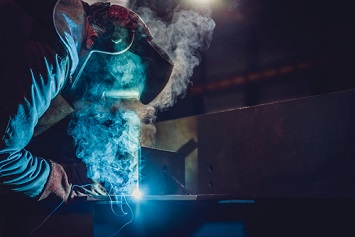If you employ welders, they may be at risk for lung cancer, regardless of the metals they weld. However, researchers have yet to compile all the information employers need on exposure limits and hazard controls.
Welding fume is now considered a known carcinogen that can lead to lung cancer, according to the International Association for Research on Cancer (IARC). Welding fume was reclassified last year from its earlier classification as “probably carcinogenic to humans.”
Employers should include the new cancer designation in any hazard communication to welders, researchers suggested in a special issue of the Journal of Occupational and Environmental Hygiene (JOEH).
Research Gaps, No PEL
While there are exposure limits for certain materials welders work with, there is no permissible or recommended occupational exposure limit for generic welding fume.
Studies show that employment as a welder is associated with development of lung cancer, according to JOEH editor-in-chief T. Renée Anthony. Cancer risk appears to rise with the length of time a worker is employed as a welder.
However, not all welding fume is the same. Welding involves a variety of methods and a wide variety of metal alloys being welded.
There are limitations to the research already performed, and more research into the cancer risk of welding fume remains to be done:
- Many of the cohort studies that pointed to the link between welding employment and lung cancer did not measure welding fume exposures;
- Studies that suggested links between welding and other cancers were limited, subject to bias, or failed to account for contributing factors like exposure to solvents;
- Researchers have not adequately studied whether or how exposure to iron in steel and various alloys contributes to the lung cancer risk, although other risks are well established; and
- Animal studies have only examined exposure to gas metal arc-welding fume; studies must also examine exposures to flux core arc welding and shielded metal arc-welding fumes.
OSHA has health and safety standards for welding, cutting, and brazing in general industry, as well as the construction, marine terminal, and shipyard industries. There are also established exposure limits for materials like hexavalent chromium and nickel.
OSHA’s suggestions for limiting exposures during welding include:
- Having workers position themselves to avoid breathing welding fume and gases—for example, staying upwind when welding in open or outdoor environments;
- Using local exhaust ventilation systems like fume hoods, fume-extractor guns, and vacuum nozzles to remove fume and gases from the welder’s breathing zone; and
- Providing respiratory protection if work practices and ventilation do not reduce exposures to safe levels.
Acting on Hazard Communication
Employers should update their hazard communication for welders, including the new cancer classification in any safety data sheets. Without an occupational exposure limit from regulators or researchers, however, employers are left to wait for more information.
Monitoring for multiple constituents of welding material would require placing multiple sample media inside a welder’s helmet. That would create an unreasonable burden for the welders. Employers can provide respiratory protection, but without a permissible or recommended exposure level, it is difficult to choose respirators with an appropriate protection factor.

